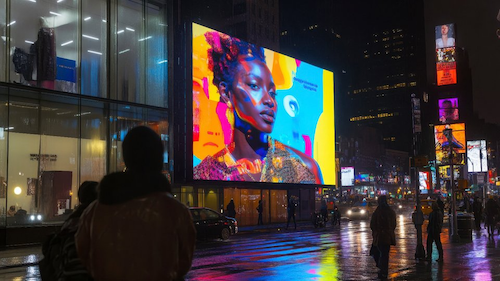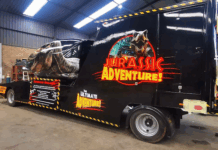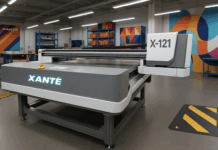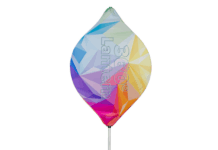Outdoor signage is no longer static or one dimensional, it’s evolving into something far more strategic. Gregg Stopher, owner, Imagine Signs of Atlanta and writing for Digital Signage Today outlines how outdoor signage is changing fast.
Businesses are experimenting with design, technology and materials in ways that redefine what a ‘sign’ can do.For sign company owners, these changes aren’t just passing trends but are signals of where the industry is headed. The signage companies that adapt quickly will transform from simple producers of signage into strategic partners who shape how businesses connect with their audiences.
Here are five major shifts redefining outdoor signage:
1. Personalisation Is No Longer Optional
Customers want signage that reflects who they are and what they stand for. Cookie cutter signs no longer cut it in an era where consumers value authenticity and connection.
Personalisation is crucial as it elevates a sign from ‘functional’ to brand defining and businesses do not mind paying more for the extra effort, ideation and creativity that goes into creating customised signs that tell their brand story. Not only this, but signs that emotionally resonate drive both offline (foot traffic) and online (Instagrammable moments) engagement.
Real world examples:
A Midtown boutique combined dimensional lettering with a mural inspired by Atlanta’s cultural roots. The result: more foot traffic, social buzz and loyal repeat customers.
Restaurants are incorporating community artwork and cultural motifs into signage such as murals featuring local artists, neon colours tied to neighboruhood identity or menu boards with storytelling elements.
Schools and non-profits often add mission driven quotes, donor recognition or cultural icons into their exterior signs to show their values.
This is where the opportunity lies. Here’s how one can make the most of it: offer ‘brand discovery sessions’ where you help businesses uncover themes, colours or cultural cues for their signs; build premium packages that bundle signage with murals, dimensional lettering or community based design.
2. Technology Isn’t Replacing Signs But Amplifying Them
We’re entering the hybrid era of signage. Static signs still anchor visibility but when paired with digital, they become living, interactive brand platforms.
Examples of tech-enabled signage:
– Retail stores: LED panels under channel letters rotate promotions in real time, reducing print costs.
– QR codes: Restaurant window decals connect passersby to menus or loyalty programmes instantly.
– Wayfinding kiosks: Malls and campuses combine directional signage with digital maps.
This is especially important for sign companies as it opens recurring revenue opportunities through digital content management, adds measurable value: clients can track scans, clicks and engagement, which differentiates you from ‘traditional’ sign shops stuck in print only solutions.
3. Sustainability Is A Selling Point
Eco consciousness has moved from ‘nice to have’ to a non-negotiable. Businesses are expected to show green commitments and signage is part of that equation.
The industry is experiencing sustainable shifts in signage such as:
– Recycled aluminium and steel for frames.
– Low VOC paints and eco friendly inks.
– Composites and laminates that extend product life and cut landfill waste.
– Energy efficient LEDs are replacing neon for illumination.
This matters for sign companies as green signage appeals to conscious consumers and helps businesses market their values. It is long lasting, eco friendly and reduces maintenance issues for clients. It offers sustainable options that elevate a shop above competitors who only pitch the cheapest materials.
Make the most of this opportunity as market sustainability has a dual benefit. It is good for the planet and good for budgets. Partner with suppliers that specialise in eco friendly materials and promote these partnerships in marketing to create a ‘green signage’ portfolio that wins bids with schools, government, and non-profits that prioritise sustainability.
4. Signs Are Becoming Multi-Purpose Tools
Outdoor signage is no longer one dimensional. Modern signs serve multiple functions at once: branding, navigation, promotions and even interaction.
Examples of multi purpose signs include:
– Hospitals: exterior signs guide visitors while reinforcing the hospital’s brand identity.
– Retail stores: Sidewalk A-frames promote sales and double as QR portals for online shopping.
– Event venues: Signs highlight promotions while serving as interactive photo backdrops for social media sharing.
This is vital for sign companies as:
– Multi purpose signage means higher ROI as clients are willing to spend more.
– Expands your scope: you’re not just designing signs, you’re designing customer experiences.
– Differentiates you from low cost competitors offering ‘single use’ signs.
– Offer ‘sign packages’ that blend multiple functions (branding, wayfinding and promotion), with the option to add interactivity as a premium upsell: tactile elements, digital tie-ins, or artistic touches.
5. Context Driven Design Wins In Complex Environments
One size fits all signage fails in today’s diverse environments. Businesses need signs that adapt to their specific context.
Context specific applications include:
– Historic districts: Dimensional lettering, traditional fonts and neutral palettes.
– Busy retail hubs: Bold colours, illuminated channel letters and high-contrast readability.
– Mixed-use developments: Digital signage for 24/7 visibility and adaptability.
– Suburban areas: Signs designed to comply with Homeowners Associations or municipal codes.
This works for sign companies as:
– Context aware design prevents costly redesigns or regulatory delays.
– Makes your business a trusted consultant in navigating zoning laws and visual clutter.
– Positions you as an expert who balances creativity with compliance.
Include this by developing ‘environment first’ packages, where you evaluate location, audience and regulations before pitching designs and training your team on local ordinances to build credibility and authority.
Outdoor signage is changing fast. What used to be a static marker is now a storytelling platform, a marketing engine and a growth tool.
The future belongs to sign companies that move beyond fabrication and become strategic partners driving client growth.
This article appears in Digital Signage Today.















